 |
|
When working with urban spaces here in Denmark, there is widespread consensus on what kind of experience-related and commercial components we must have in place to make an urban space rich in experience and quality. Our attitudes on how urban spaces should be arranged and designed quite tellingly reflect our distinctive brand of capitalism with a human face – and are also testament to a stable canon for what is considered good quality. However, you do not need to venture far beyond the borders of Europe to find that such dogma no longer apply. Just a single stroll down Bangkok’s Sukhumvit Road – the most dynamic and commercial site in Thailand, perhaps even in all of Southeast Asia – clearly demonstrates that the qualities that Western Europeans regard as important, such as reflection, slowness, history, and, ultimately, democracy, do not in any way apply as parameters for the planning of the aesthetics or infrastructure found in these urban spaces’. Here, instant and direct consumption and the greatest possible speed of expenditure determines and shapes the urban space. The ongoing struggle to offer the most attractive consumer experience on one’s own turf, always in competition with other site owners, sets the framework for what you can do in the public space. Art in the urban space is all very well and good, but only if it is conducive to a consumer experience. Placing a bench for people to soak up the sun is obviously irrelevant in a country where the average temperature reaches 35 degrees centigrade – doubly so when you consider how its social structures require each individual to work for as long as he/she can stand up. Nevertheless, the city offers great and intense experiences. Where else can you find roads and trains crossing the urban spaces, stacked on top of each other in several tiers? And where else would you find huge shopping malls in such quantities, linked by walkways, underground passages and tunnels so that you could live an entire parallel existence in the indoor streets and squares of malls without ever coming across a public road or square, and without ever having to leave the space of consumption behind. |
||||
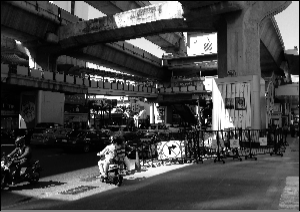 |
||||
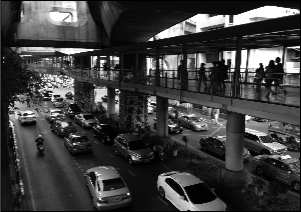 |
||||
There is no such thing as recreational urban spaces in Bangkok. Certainly not if by “recreational” you mean behaviour that is not directed towards a specific target or objective, a calm, meandering enjoyment of surroundings that have been designed using aesthetic devices that invite calm reflection and recreation. And yet you will find countless situations where the inhabitants of these streets engage in recreational activities. Everywhere you will see people sleeping, eating, resting, child-minding, talking – right in the midst of this hysterical inferno of commerce and traffic. The difference is that their recreational activity is not linked to aesthetics. The spaces they occupy for their recreational purposes were not prepared for such usage by architects, designers and artists; rather, they are spaces that have been left over and overlooked in the hubbub of city life. Very often, they are spaces where Europeans would never even think of settling. For example when people find rest and relaxation in the median strip separating three lanes of traffic on either side; underneath a bridge (because it provides shelter against the frequent rain), or at the side of the road while you try to sell three Durian fruits you brought along from home. This is not to say that aesthetics are not necessary, for indeed they are – more than ever. But perhaps we might up their game. Is it right and proper that aesthetically beautiful and carefully crafted urban spaces are the exclusive province of leisure activities? Might one not envision urban planners, architects and artists descending from their ivory towers, engaging in direct, one-to-one contact with those aspects of life that are non-recreational, alien to art? Might not those spaces also be imbued with special qualities? |
||
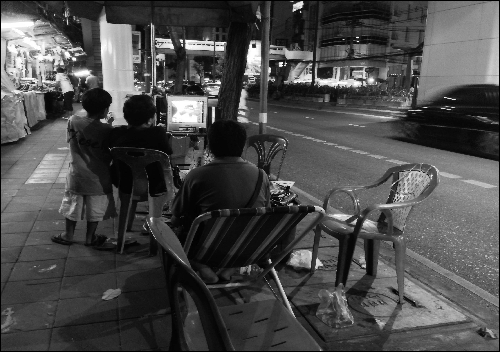 |
||
Even though Bangkok is home to fifteen million people and has a history that stands among the medium-long histories of cities worldwide, the city is nevertheless exhausted of experiences in two to three days – unless you have a special predilection for consumer goods. Few layers of history are apparent in the urban space. Maybe the reason for this is the fact that Thai architecture was built out of wood in the past, which means that its historical urban spaces and buildings have disappeared; this might explain why historical aspects play such a small part of the overall impression. (A standard wooden pallet will be eaten by termites in three months here, leaving only the nails). Maybe it is because there is no general awareness of the qualities inherent in the old urban spaces – perhaps they are too far removed from the modernity they so desperately want to take over from the Western world. Or perhaps it is because art and literature in this part of the world has not cast a veil of picturesque decay over the tough realities of the struggle for survival? Whatever the case may be, the experience certainly lacks layers. If we turn our eye towards Europe, we see that many artists on our continent, such as the artists of the nineteenth century, have managed to draw a conciliatory veil over the battle for survival with their barrage of depictions of everyday toil – scenes of poor Italian peasants were a particular favourite. Those artists were so successful that even now, 150 years later, we still believe a little in the myth of the jolly, temperamental pauper. Also, the constant cultural processing of urban spaces has given us a sense of layered depth that can, in many ways, be likened to the perception of nature seen in times gone by. There may, then, be something to the idea that those traces of memory, those relics of historical periods and the artistic processing thereof that we Europeans celebrate as bearers of meaning do actually have an impact on the moderation and intensification of urban spaces. |
||
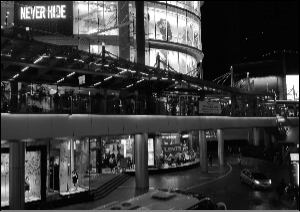 |
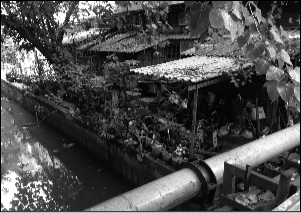 |
|||
It is not that the Asian metropolis has no aesthetics offerings to make. There are plenty of aesthetic statements to be found in this city. However, all of those statements are associated with consumption, with individual commodities and with individual persons. The entire city teems with any European design object your heart could possibly desire, from Balenciaga bags to Eames chairs. From the cheap knock-offs sold by street vendors to the special floor in the shopping mall where you can stroll right in and buy yourself a Ferrari or a Lamborghini. However, there are no ‘intention-less’, purposeless aesthetic objects here. And you find no notions about a correlation between aesthetics and contemplation – or, more accurately, between aesthetics and society/commity. Anyone can build themselves their own aesthetic universe out of a fixed set of designer brands, but that does not concern anyone else. The space devoted to traffic is a public concern, but the aesthetic shaping and design of the urban space is left in the hands of private enterprise. |
||
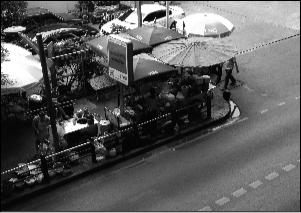 |
||||
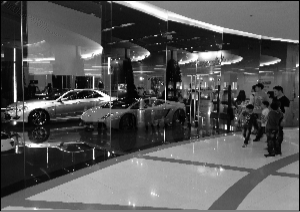 |
||||
Using Bangkok (and other Asian cities) as a role model for designing cities hardly seems feasible. But they do provide eye-opening insight into what happens if we surrender ourselves unreservedly to designs and aesthetics whose main objective is to coax money from our pockets (to quote the US artist Trueism: ”I shop, therefore I am”). Successful art and architecture is aesthetics without any hidden commercial agenda. A refuge for body and mind.
Blog entry for Arkitektur.dk, October 2012 |
||